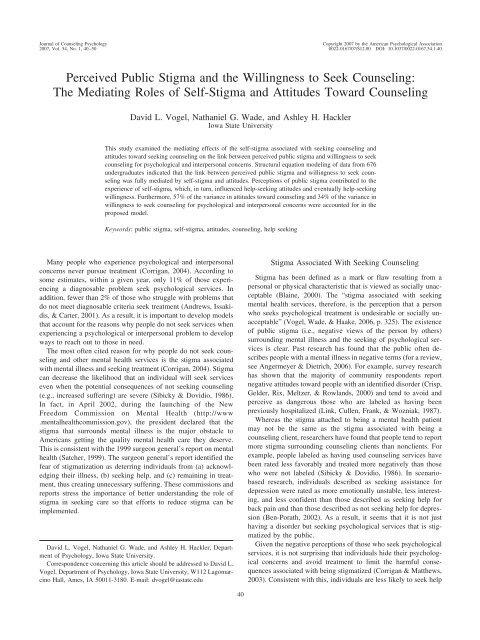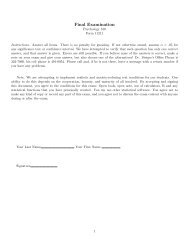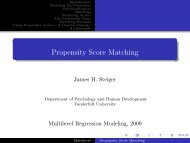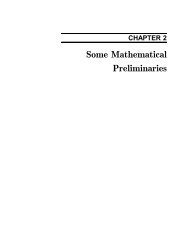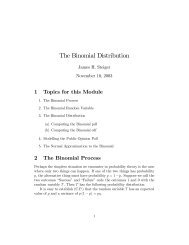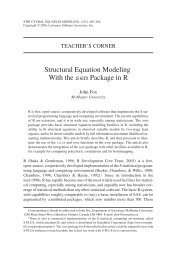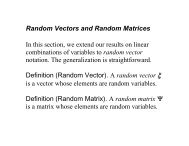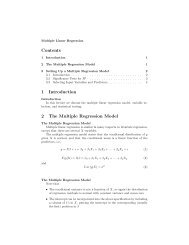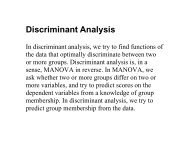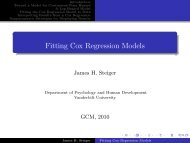Perceived Public Stigma and the Willingness to Seek Counseling ...
Perceived Public Stigma and the Willingness to Seek Counseling ...
Perceived Public Stigma and the Willingness to Seek Counseling ...
Create successful ePaper yourself
Turn your PDF publications into a flip-book with our unique Google optimized e-Paper software.
Journal of <strong>Counseling</strong> PsychologyCopyright 2007 by <strong>the</strong> American Psychological Association2007, Vol. 54, No. 1, 40–50 0022-0167/07/$12.00 DOI: 10.1037/0022-0167.54.1.40<strong>Perceived</strong> <strong>Public</strong> <strong>Stigma</strong> <strong>and</strong> <strong>the</strong> <strong>Willingness</strong> <strong>to</strong> <strong>Seek</strong> <strong>Counseling</strong>:The Mediating Roles of Self-<strong>Stigma</strong> <strong>and</strong> Attitudes Toward <strong>Counseling</strong>David L. Vogel, Nathaniel G. Wade, <strong>and</strong> Ashley H. HacklerIowa State UniversityThis study examined <strong>the</strong> mediating effects of <strong>the</strong> self-stigma associated with seeking counseling <strong>and</strong>attitudes <strong>to</strong>ward seeking counseling on <strong>the</strong> link between perceived public stigma <strong>and</strong> willingness <strong>to</strong> seekcounseling for psychological <strong>and</strong> interpersonal concerns. Structural equation modeling of data from 676undergraduates indicated that <strong>the</strong> link between perceived public stigma <strong>and</strong> willingness <strong>to</strong> seek counselingwas fully mediated by self-stigma <strong>and</strong> attitudes. Perceptions of public stigma contributed <strong>to</strong> <strong>the</strong>experience of self-stigma, which, in turn, influenced help-seeking attitudes <strong>and</strong> eventually help-seekingwillingness. Fur<strong>the</strong>rmore, 57% of <strong>the</strong> variance in attitudes <strong>to</strong>ward counseling <strong>and</strong> 34% of <strong>the</strong> variance inwillingness <strong>to</strong> seek counseling for psychological <strong>and</strong> interpersonal concerns were accounted for in <strong>the</strong>proposed model.Keywords: public stigma, self-stigma, attitudes, counseling, help seekingMany people who experience psychological <strong>and</strong> interpersonalconcerns never pursue treatment (Corrigan, 2004). According <strong>to</strong>some estimates, within a given year, only 11% of those experiencinga diagnosable problem seek psychological services. Inaddition, fewer than 2% of those who struggle with problems thatdo not meet diagnosable criteria seek treatment (Andrews, Issakidis,& Carter, 2001). As a result, it is important <strong>to</strong> develop modelsthat account for <strong>the</strong> reasons why people do not seek services whenexperiencing a psychological or interpersonal problem <strong>to</strong> developways <strong>to</strong> reach out <strong>to</strong> those in need.The most often cited reason for why people do not seek counseling<strong>and</strong> o<strong>the</strong>r mental health services is <strong>the</strong> stigma associatedwith mental illness <strong>and</strong> seeking treatment (Corrigan, 2004). <strong>Stigma</strong>can decrease <strong>the</strong> likelihood that an individual will seek serviceseven when <strong>the</strong> potential consequences of not seeking counseling(e.g., increased suffering) are severe (Sibicky & Dovidio, 1986).In fact, in April 2002, during <strong>the</strong> launching of <strong>the</strong> NewFreedom Commission on Mental Health (http://www.mentalhealthcommission.gov), <strong>the</strong> president declared that <strong>the</strong>stigma that surrounds mental illness is <strong>the</strong> major obstacle <strong>to</strong>Americans getting <strong>the</strong> quality mental health care <strong>the</strong>y deserve.This is consistent with <strong>the</strong> 1999 surgeon general’s report on mentalhealth (Satcher, 1999). The surgeon general’s report identified <strong>the</strong>fear of stigmatization as deterring individuals from (a) acknowledging<strong>the</strong>ir illness, (b) seeking help, <strong>and</strong> (c) remaining in treatment,thus creating unnecessary suffering. These commissions <strong>and</strong>reports stress <strong>the</strong> importance of better underst<strong>and</strong>ing <strong>the</strong> role ofstigma in seeking care so that efforts <strong>to</strong> reduce stigma can beimplemented.David L. Vogel, Nathaniel G. Wade, <strong>and</strong> Ashley H. Hackler, Departmen<strong>to</strong>f Psychology, Iowa State University.Correspondence concerning this article should be addressed <strong>to</strong> David L.Vogel, Department of Psychology, Iowa State University, W112 LagomarcinoHall, Ames, IA 50011-3180. E-mail: dvogel@iastate.edu<strong>Stigma</strong> Associated With <strong>Seek</strong>ing <strong>Counseling</strong><strong>Stigma</strong> has been defined as a mark or flaw resulting from apersonal or physical characteristic that is viewed as socially unacceptable(Blaine, 2000). The “stigma associated with seekingmental health services, <strong>the</strong>refore, is <strong>the</strong> perception that a personwho seeks psychological treatment is undesirable or socially unacceptable”(Vogel, Wade, & Haake, 2006, p. 325). The existenceof public stigma (i.e., negative views of <strong>the</strong> person by o<strong>the</strong>rs)surrounding mental illness <strong>and</strong> <strong>the</strong> seeking of psychological servicesis clear. Past research has found that <strong>the</strong> public often describespeople with a mental illness in negative terms (for a review,see Angermeyer & Dietrich, 2006). For example, survey researchhas shown that <strong>the</strong> majority of community respondents reportnegative attitudes <strong>to</strong>ward people with an identified disorder (Crisp,Gelder, Rix, Meltzer, & Rowl<strong>and</strong>s, 2000) <strong>and</strong> tend <strong>to</strong> avoid <strong>and</strong>perceive as dangerous those who are labeled as having beenpreviously hospitalized (Link, Cullen, Frank, & Wozniak, 1987).Whereas <strong>the</strong> stigma attached <strong>to</strong> being a mental health patientmay not be <strong>the</strong> same as <strong>the</strong> stigma associated with being acounseling client, researchers have found that people tend <strong>to</strong> reportmore stigma surrounding counseling clients than nonclients. Forexample, people labeled as having used counseling services havebeen rated less favorably <strong>and</strong> treated more negatively than thosewho were not labeled (Sibicky & Dovidio, 1986). In scenariobasedresearch, individuals described as seeking assistance fordepression were rated as more emotionally unstable, less interesting,<strong>and</strong> less confident than those described as seeking help forback pain <strong>and</strong> than those described as not seeking help for depression(Ben-Porath, 2002). As a result, it seems that it is not justhaving a disorder but seeking psychological services that is stigmatizedby <strong>the</strong> public.Given <strong>the</strong> negative perceptions of those who seek psychologicalservices, it is not surprising that individuals hide <strong>the</strong>ir psychologicalconcerns <strong>and</strong> avoid treatment <strong>to</strong> limit <strong>the</strong> harmful consequencesassociated with being stigmatized (Corrigan & Mat<strong>the</strong>ws,2003). Consistent with this, individuals are less likely <strong>to</strong> seek help40
SELF-STIGMA41for issues that are viewed negatively by o<strong>the</strong>rs (Overbeck, 1977).In addition, surveys of undergraduate students have found thatthose who endorse stigmas of <strong>the</strong> mentally ill are less likely <strong>to</strong> seekpsychological help (Cooper, Corrigan, & Watson, 2003). Researchershave also found that perceptions of counseling stigmapredict attitudes <strong>to</strong>ward seeking counseling (Deane & Todd, 1996;Komiya, Good, & Sherrod, 2000; Vogel, Wester, Wei, & Boysen,2005) as well as willingness <strong>to</strong> seek counseling (Rochlen, Mohr, &Hargrove, 1999). Survey research with community samples hasalso found that <strong>the</strong> fear of being viewed as crazy is a commonbarrier <strong>to</strong> seeking professional help (Nelson & Barbaro, 1985) <strong>and</strong>that participants who do not seek <strong>the</strong>rapy are more likely <strong>to</strong> reportstigma as a treatment barrier than those who do (Stefl & Prosperi,1985). Fur<strong>the</strong>rmore, <strong>the</strong> stigma associated with mental illness hasbeen linked <strong>to</strong> <strong>the</strong> early termination of treatment (Sirey et al.,2001). In all, <strong>the</strong>re is clear support that awareness of <strong>the</strong> stigmaassociated with seeking treatment has a negative influence onpeople’s attitudes <strong>to</strong>ward seeking help <strong>and</strong> keeps many peoplefrom seeking help even when <strong>the</strong>y have significant problems.The Role of Self-<strong>Stigma</strong>Despite <strong>the</strong> awareness of <strong>the</strong> relationship between perceivedpublic stigma <strong>and</strong> <strong>the</strong> decision <strong>to</strong> seek treatment, <strong>the</strong> complex rolethat stigma plays in this decision-making process is not fullyknown. Corrigan (1998, 2004) asserted that <strong>the</strong>re are two separatetypes of stigma affecting an individual’s decision <strong>to</strong> seek treatment.The first, public stigma, is <strong>the</strong> perception held by o<strong>the</strong>rs (i.e.,by society) that an individual is socially unacceptable. The second,self-stigma, is <strong>the</strong> perception held by <strong>the</strong> individual that he or sheis socially unacceptable, which can lead <strong>to</strong> a reduction in selfesteemor self-worth if <strong>the</strong> person seeks psychological help (Vogelet al., 2006). In o<strong>the</strong>r words, <strong>the</strong> negative images expressed bysociety <strong>to</strong>ward those who seek psychological services may beinternalized (Corrigan, 1998, 2004; Holmes & River, 1998) <strong>and</strong>lead people <strong>to</strong> perceive <strong>the</strong>mselves as inferior, inadequate, or weak(Nadler & Fisher, 1986). As a result, people higher in self-stigmamay decide <strong>to</strong> forego psychological services <strong>to</strong> maintain a positiveimage of <strong>the</strong>mselves (Miller, 1985).Whereas <strong>the</strong> direct relationship of perceived public stigma onone’s willingness <strong>to</strong> seek psychological services is well established,<strong>the</strong> role of self-stigma has only recently been addressed.Related research, however, has shown that people can internalizenegative perceptions when dealing with mental health issues (Link,1987; Link & Phelan, 2001) <strong>and</strong> that being labeled mentally ill canlead <strong>to</strong> lower self-esteem (Link, Struening, Neese-Todd, Asmussen,& Phelan, 2001). In addition, modified labeling <strong>the</strong>ory assertsthat societal devaluation <strong>and</strong> discrimination <strong>to</strong>ward <strong>the</strong> mentally illcould directly lead <strong>to</strong> negative consequences for people’s selfesteemif <strong>the</strong>y are labeled, by <strong>the</strong>mselves or o<strong>the</strong>rs, as having amental illness or as being in need of psychological care (Link,Cullen, Struening, Shrout, & Dohrenwend, 1989). Consistent withthis, perceptions of stigma surrounding mental illness are related <strong>to</strong>lower self-esteem for those suffering from a mental illness (Link etal., 1987). Research has also shown that individuals are less likely<strong>to</strong> ask for help from nonprofessional sources, such as friends, if<strong>the</strong>y fear embarrassment (Mayer & Timms, 1970) or if asking forhelp would lead <strong>the</strong>m <strong>to</strong> feel inferior or incompetent (Nadler, 1991).One study has directly measured <strong>the</strong> role of self-stigma inpredicting psychological help-seeking attitudes <strong>and</strong> willingness <strong>to</strong>seek counseling (Vogel et al., 2006). This study showed thatself-stigma was conceptually different from o<strong>the</strong>r, potentially relatedconstructs, such as self-esteem <strong>and</strong> public stigma, suggestingthat self-stigma is potentially unique in <strong>the</strong> conceptualization ofhelp-seeking behavior. Supporting this, self-stigma uniquely predictedattitudes <strong>to</strong>ward seeking psychological help <strong>and</strong> willingness<strong>to</strong> seek counseling above previously identified fac<strong>to</strong>rs. It is interestingthat <strong>the</strong> role of perceived public stigma in predicting attitudes<strong>to</strong>ward <strong>and</strong> willingness <strong>to</strong> seek counseling was reduced whenself-stigma was entered in<strong>to</strong> <strong>the</strong> model. This suggests that selfstigmamay mediate <strong>the</strong> relationship between perceived publicstigma <strong>and</strong> attitudes <strong>to</strong>ward seeking help as well as willingness <strong>to</strong>seek help. This mediating relationship makes sense, as publicstigma’s effect on one’s decision <strong>to</strong> seek help may have as muchor more <strong>to</strong> do with <strong>the</strong> internalization of societal messages aboutwhat it means <strong>to</strong> be mentally ill (Link et al., 1989) or <strong>to</strong> seekpsychological services. The internalization can lead <strong>to</strong> shame <strong>and</strong>loss of self-esteem (Link, 1987), <strong>and</strong> <strong>the</strong> attempt <strong>to</strong> avoid thosefeelings may have <strong>the</strong> most direct effect on an individual’s attitudes<strong>to</strong>ward <strong>and</strong> willingness <strong>to</strong> seek counseling. This hypo<strong>the</strong>sis,however, has not been empirically tested; only <strong>the</strong> direct effects ofpublic <strong>and</strong> self-stigma on attitudes <strong>to</strong>ward <strong>and</strong> willingness <strong>to</strong> seekcounseling have been examined. As a result, we do not know <strong>the</strong>full relative effect of <strong>the</strong> different types of stigma on <strong>the</strong> decision<strong>to</strong> seek psychological help.Sex Differences in Perceptions of <strong>Stigma</strong>Studies consistently find that women are more likely <strong>to</strong> seekhelp for emotional issues (Moller-Leimkuhler, 2002) <strong>and</strong> possessmore positive attitudes <strong>to</strong>ward counseling than men (Fischer &Farina, 1995). One reason may be that men perceive greater stigmaassociated with seeking help. Society considers counseling <strong>to</strong> be alast resort, something <strong>to</strong> use only after o<strong>the</strong>r sources of supporthave failed (Angermeyer, Matschinger, & Riedel-Heller, 1999).Such attitudes may be particularly salient for men, who are expected<strong>to</strong> be s<strong>to</strong>ic, controlled, <strong>and</strong> self-sufficient (Hammen &Peters, 1977). Consistent with this, adolescents are more willing <strong>to</strong>refer a girl <strong>to</strong> get help than a boy (Raviv, Sills, Raviv, & Wilansky,2000). Thus, men may perceive that <strong>the</strong>re is public stigma associatedwith <strong>the</strong>ir seeking help (Timlin-Scalera, Ponterot<strong>to</strong>, Blumberg,& Jackson, 2003) <strong>and</strong> believe that <strong>the</strong>y would be stigmatizedfor discussing certain issues with a counselor (Martin, Wrisberg,Beitel, & Lounsbury, 1997). Similarly, <strong>the</strong> emphasis of <strong>the</strong> traditionalmale gender role on being independent <strong>and</strong> in control maylead <strong>to</strong> increased concerns about <strong>the</strong> loss of self-esteem associatedwith seeking help, as it may mean admitting <strong>to</strong> <strong>the</strong> inability <strong>to</strong>h<strong>and</strong>le things on one’s own (Addis & Mahalik, 2003). Therefore,if a man believed that he needed counseling, he might experiencea greater sense of failure, which would make <strong>the</strong> act of asking forhelp particularly difficult. Consistent with this, men have beenfound <strong>to</strong> experience greater self-stigma than women regarding helpseeking in college settings (Vogel et al., 2006).The Current StudyAlthough perceptions of public stigma may play an importantrole in <strong>the</strong> help-seeking process, it is difficult <strong>to</strong> alter, as it mayrequire societal changes. However, interventions designed <strong>to</strong> reduceor alter <strong>the</strong> self-stigma associated with seeking help may
42 VOGEL, WADE, AND HACKLERencourage people <strong>to</strong> make use of counseling. Thus, a better underst<strong>and</strong>ingof how public <strong>and</strong> self-stigma relate <strong>to</strong> <strong>the</strong> helpseekingprocess can be used <strong>to</strong> boost service usage through outreach<strong>and</strong> educational programs. As a result, <strong>the</strong> goal of thisresearch is <strong>to</strong> exp<strong>and</strong> on <strong>the</strong> previous literature by using structuralequation modeling (SEM) analyses <strong>to</strong> examine <strong>the</strong> hypo<strong>the</strong>sis that<strong>the</strong> relationship between perceived public stigma <strong>and</strong> willingness<strong>to</strong> seek counseling will be indirectly mediated by self-stigma <strong>and</strong>attitudes <strong>to</strong>ward seeking help (see Figure 1).Our approach builds on previous work by Vogel <strong>and</strong> Wester(2003), who examined a general model of help seeking based onAjzen <strong>and</strong> Fishbein’s (1980) <strong>the</strong>ory of reasoned action. According<strong>to</strong> this model, one of <strong>the</strong> primary determinants of <strong>the</strong> willingness<strong>to</strong> seek help is one’s attitude <strong>to</strong>ward <strong>the</strong> counseling process. Theseattitudes are formed through an evaluation of <strong>the</strong> expectations <strong>the</strong>individual has about seeking psychological help (e.g., <strong>the</strong> degree ofpublic <strong>and</strong> self-stigma <strong>the</strong> person experiences). On <strong>the</strong> basis of thismodel, <strong>the</strong> perceptions of stigma (e.g., “If I seek help o<strong>the</strong>rs willthink I am crazy”) should influence one’s attitudes, which, in turn,should influence one’s willingness <strong>to</strong> seek help (Vogel & Wester,2003). In addition, because <strong>the</strong> influence of perceived publicstigma on an individual’s attitudes <strong>and</strong> willingness <strong>to</strong> seek counselinghas been found <strong>to</strong> noticeably decrease with <strong>the</strong> inclusion ofself-stigma in <strong>the</strong> model <strong>and</strong> because self-stigma predicts helpseekingattitudes <strong>and</strong> willingness (Vogel et al., 2006), we specificallyhypo<strong>the</strong>size that <strong>the</strong> effect of public stigma on help-seekingattitudes will be fully mediated through self-stigma <strong>and</strong> that selfstigma<strong>and</strong> <strong>the</strong>n attitudes will fully mediate <strong>the</strong> effect of publicstigma on help-seeking willingness. In particular, public stigmawill be positively related <strong>to</strong> self-stigma, self-stigma will <strong>the</strong>n benegatively related <strong>to</strong> attitudes <strong>to</strong>ward counseling, <strong>and</strong> attitudeswill, in turn, be positively related <strong>to</strong> <strong>the</strong> willingness <strong>to</strong> seekcounseling. Finally, given <strong>the</strong> need for researchers <strong>to</strong> fur<strong>the</strong>rexamine potential differences between relations of stigma <strong>and</strong>help-seeking willingness for women <strong>and</strong> men, we examine <strong>the</strong>fac<strong>to</strong>rial invariance of <strong>the</strong> model across sex.ParticipantsMethodCollege students (N 680) recruited from psychology classes at a largemidwestern university participated in this study. Participants were evenlysplit between men <strong>and</strong> women <strong>and</strong> were predominantly 1st-year (48%) or2nd-year (30%) students. The rest were 3rd-year (13%) students, were4th-year (8%) students, or did not report <strong>the</strong>ir year in school (1%).Participants were predominantly European American (90%; Asian American 4%, African American 2%, Hispanic 2%, international 1%,<strong>and</strong> o<strong>the</strong>r 1%).Measures<strong>Perceived</strong> public stigma. <strong>Perceived</strong> public stigma was measured with<strong>the</strong> 12-item <strong>Perceived</strong> Devaluation–Discrimination scale (Link et al.,1987). Participants rated from 1 (strongly agree) <strong>to</strong>6(strongly disagree)<strong>the</strong> degree <strong>to</strong> which <strong>the</strong>y believed statements about how most people viewcurrent or former psychiatric patients. A sample item is “Most peoplewould not hire a former mental patient <strong>to</strong> take care of <strong>the</strong>ir children, evenif he or she had been well for some time.” Higher scores represent greaterperceived stigma. Estimates of internal consistency range from .76 <strong>to</strong> .88among clinical <strong>and</strong> community samples (Link et al., 1989, 2001). Theinternal consistency of <strong>the</strong> scores obtained in <strong>the</strong> current sample was .83.Validity has been shown through a relationship between this scale <strong>and</strong> <strong>the</strong>internal experience of demoralization <strong>and</strong> lower self-esteem among acommunity sample 6 months <strong>and</strong> 24 months later (Link et al., 2001).Self-stigma. Self-stigma was measured with <strong>the</strong> Self-<strong>Stigma</strong> of <strong>Seek</strong>ingHelp Scale (SSOSH; Vogel et al., 2006). The SSOSH is a 10-item scaleconsisting of items such as “I would feel inadequate if I went <strong>to</strong> a <strong>the</strong>rapistfor psychological help.” Items are rated on a 5-point, partly anchored scaleranging from 1 (strongly disagree) <strong>to</strong>5(strongly agree). Scale point 3 isanchored by agree <strong>and</strong> disagree equally. Higher scores reflect greaterself-stigma. Estimates of <strong>the</strong> internal consistency range from .86 <strong>to</strong> .90, <strong>and</strong><strong>the</strong> 2-week test–retest reliability has been reported <strong>to</strong> be .72 in collegestudent samples (Vogel et al., 2006). The internal consistency of <strong>the</strong> scoresobtained in <strong>the</strong> current sample was .89. The SSOSH has been shown <strong>to</strong>have a unidimensional fac<strong>to</strong>r structure <strong>and</strong> evidence of validity throughcorrelations with attitudes <strong>to</strong>ward seeking professional help <strong>and</strong> intention<strong>to</strong> seek counseling (rs .53 <strong>to</strong> .63 <strong>and</strong> .32 <strong>to</strong> .38, respectively;Vogel et al., 2006). The SSOSH also differentiated college students whosought psychological services from those who did not across a 2-monthperiod (Vogel et al., 2006).Attitudes <strong>to</strong>ward seeking professional help. Attitudes <strong>to</strong>ward seekingprofessional help were measured with <strong>the</strong> Attitudes Towards <strong>Seek</strong>ingProfessional Psychological Help Scale (Fischer & Farina, 1995). This is a10-item revision of <strong>the</strong> original 29-item measure (Fischer & Turner, 1970),consisting of items such as “If I believed I was having a mental breakdown,my first inclination would be <strong>to</strong> get professional attention.” Items are ratedfrom 1 (disagree) <strong>to</strong> 4 (agree), with higher scores reflecting positiveattitudes. The revised <strong>and</strong> original scales are correlated .87, suggesting that<strong>the</strong>y tap in<strong>to</strong> a similar construct (Fischer & Farina, 1995). The revised scalealso correlates with previous use of professional help for a problem (r .39). Estimates of <strong>the</strong> internal consistency ( .84) <strong>and</strong> 1-month test–retest (r .80) reliabilities have been reported for college student samples.The internal consistency of <strong>the</strong> scores obtained in <strong>the</strong> current sample was.80. Fischer <strong>and</strong> Farina have successfully used <strong>the</strong> measure <strong>to</strong> differentiatebetween college students with serious emotional or personal problems whosought counseling <strong>and</strong> those with comparable problems who did not. Forcollege students, <strong>the</strong> scale has a positive association (r .56) withintentions <strong>to</strong> seek counseling <strong>and</strong> correlates negatively (r .19) withself-concealment tendencies (Vogel et al., 2005).<strong>Willingness</strong> <strong>to</strong> seek counseling for psychological <strong>and</strong> interpersonalconcerns. <strong>Willingness</strong> <strong>to</strong> seek counseling for psychological <strong>and</strong> interpersonalconcerns was measured with <strong>the</strong> Intentions <strong>to</strong> <strong>Seek</strong> <strong>Counseling</strong>Inven<strong>to</strong>ry (ISCI; Cash, Begley, McCown, & Weise, 1975). The ISCI is a17-item measure wherein respondents rate from 1 (very unlikely)<strong>to</strong>4(verylikely) how likely <strong>the</strong>y would be <strong>to</strong> seek counseling if <strong>the</strong>y were experiencing<strong>the</strong> problem listed. Problems include issues such as relationshipdifficulties, depression, personal worries, <strong>and</strong> drug problems. Fac<strong>to</strong>r analysisof <strong>the</strong> ISCI supports <strong>the</strong> existence of three subscales within <strong>the</strong>measure, labeled Psychological <strong>and</strong> Interpersonal Concerns (10 items; .90), Academic Concerns (4 items; .71), <strong>and</strong> Drug Use Concerns (2Figure 1.Hypo<strong>the</strong>sized mediated model.
SELF-STIGMA43items; .86), with correlations among <strong>the</strong> subscales ranging from .18 <strong>to</strong>.50 (Cepeda-Beni<strong>to</strong> & Short, 1998). To reduce participant burden, we usedonly <strong>the</strong> Psychological <strong>and</strong> Interpersonal Concerns subscale (covering,e.g., loneliness, depression, <strong>and</strong> inferiority feelings) in <strong>the</strong> present study.Scale responses are summed, with higher scores indicating a greaterlikelihood of seeking counseling for psychological <strong>and</strong> interpersonal concerns.The internal consistency of <strong>the</strong> scores on <strong>the</strong> Psychological <strong>and</strong>Interpersonal Concerns subscale in <strong>the</strong> current sample was .87. Amongcollege students, <strong>the</strong> ISCI has been found <strong>to</strong> correlate with <strong>the</strong> perceivedsignificance of a current problem <strong>and</strong> with general attitudes <strong>to</strong>ward seekinghelp (r .36; Kelly & Achter, 1995).ProcedureStudents were recruited <strong>to</strong> participate in <strong>the</strong> study through announcementsin <strong>the</strong>ir psychology classes <strong>and</strong> participated voluntarily. Theseannouncements stated that <strong>the</strong>y would be filling out questionnaires about<strong>the</strong>ir attitudes <strong>and</strong> perceptions. Participants attended testing sessions inlarge groups. After completing an informed consent sheet, participantsreceived a packet containing each of <strong>the</strong> above measures as well as somedemographic questions (i.e., biological sex, year in school, ethnicity). Toassess previous use of counseling services, we asked participants whe<strong>the</strong>r<strong>the</strong>y “had ever used or are currently using counseling services (Yes/No).”To reduce <strong>the</strong> potential for order effects, we created three versions of <strong>the</strong>questionnaire, with <strong>the</strong> measures r<strong>and</strong>omly presented in each version. Afterfinishing <strong>the</strong> questionnaire, participants were debriefed <strong>and</strong> <strong>the</strong>n dismissed.All participants received extra credit in <strong>the</strong>ir psychology class for <strong>the</strong>irparticipation <strong>and</strong> had been offered an equivalent option (i.e., participate inano<strong>the</strong>r experiment or a writing assignment) <strong>to</strong> earn <strong>the</strong> extra credit. TheUniversity Human Subjects Research Office approved <strong>the</strong> study procedure.ResultsPreliminary AnalysisOutliers. To check for univariate outliers, we examined <strong>the</strong> zscores of each of <strong>the</strong> overall scales (Tabachnick & Fidell, 2001). Intwo cases (on <strong>the</strong> ISCI), <strong>the</strong>re were outliers at p .001 (i.e., zscores above 3.29). Thus, we removed <strong>the</strong>se two cases fromsubsequent analyses. To check for multivariate outliers, we examinedMahalanobis distances among <strong>the</strong> variables (Tabachnick &Fidell, 2001). Two additional cases were found <strong>to</strong> be outliers atp .001 (Mahalanobis distance 18.46) <strong>and</strong> so were droppedfrom subsequent analyses (n 676).Zero-order correlations. Table 1 shows means, st<strong>and</strong>ard deviations,<strong>and</strong> zero-order correlations for <strong>the</strong> overall scales. Asexpected, <strong>the</strong> zero-order correlations showed that perceived publicstigma <strong>and</strong> self-stigma were significantly related <strong>to</strong> each o<strong>the</strong>r, <strong>to</strong>attitudes <strong>to</strong>ward seeking professional psychological help, <strong>and</strong> <strong>to</strong>willingness <strong>to</strong> seek counseling. Attitudes were also significantlyrelated <strong>to</strong> willingness <strong>to</strong> seek counseling.Testing Mediated EffectsIt is generally agreed that SEM is <strong>the</strong> preferred method fortesting mediation (Frazier, Tix, & Barron, 2004; MacKinnon,Lockwood, Hoffman, West, & Sheets, 2002). With regard <strong>to</strong>testing mediation using SEM, Anderson <strong>and</strong> Gerbing (1988) suggestedfollowing a two-step procedure: (a) conducting a confirma<strong>to</strong>ryfac<strong>to</strong>r analysis <strong>to</strong> develop a measurement model with anacceptable fit <strong>to</strong> <strong>the</strong> data, <strong>and</strong> <strong>the</strong>n (b) conducting a structuralmodel <strong>to</strong> test <strong>the</strong> hypo<strong>the</strong>sized relationships. We also followed <strong>the</strong>recommendation of Holmbeck (1997) <strong>and</strong> compared our hypoth-Table 1Means, St<strong>and</strong>ard Deviations, <strong>and</strong> Zero-Order CorrelationsMeasure M SD 1 2 3 41. <strong>Willingness</strong> 20.6 5.7 — .50 *** .09 * .37 ***2. Attitudes 25.8 5.4 — .12 ** .65 ***3. <strong>Public</strong> <strong>Stigma</strong> 46.9 9.4 — .25 ***4. Self-<strong>Stigma</strong> 28.5 7.4 —Note. N 676. <strong>Willingness</strong> Psychological <strong>and</strong> Interpersonal Concernssubscale of <strong>the</strong> Intent <strong>to</strong> <strong>Seek</strong> <strong>Counseling</strong> Inven<strong>to</strong>ry; Attitudes AttitudesTowards <strong>Seek</strong>ing Professional Psychological Help Scale; <strong>Public</strong> <strong>Stigma</strong> <strong>Perceived</strong> Devaluation–Discrimination Scale; Self-<strong>Stigma</strong> Self-<strong>Stigma</strong>of <strong>Seek</strong>ing Help Scale.* p .05.** p .01.*** p .001.esized, fully mediated structural model with a partially mediatedstructural model <strong>to</strong> select <strong>the</strong> best fitting model. We used <strong>the</strong>maximum likelihood method in <strong>the</strong> LISREL 8.54 program <strong>to</strong>examine <strong>the</strong> measurement <strong>and</strong> structural models. Four indexeswere used <strong>to</strong> assess <strong>the</strong> goodness of fit of <strong>the</strong> models: <strong>the</strong> comparativefit index (CFI; .95 or greater), <strong>the</strong> incremental fit index(IFI; .95 or greater), <strong>the</strong> st<strong>and</strong>ardized root-mean-square residual(SRMR; .08 or less), <strong>and</strong> <strong>the</strong> root-mean-square error of approximation(RMSEA; .06 or less; see Hu & Bentler, 1999; Martens, 2005).Item parcels. Following <strong>the</strong> recommendation of Russell,Kahn, Spoth, <strong>and</strong> Altmaier (1998), we created observed indica<strong>to</strong>rs(parcels) for <strong>the</strong> latent variables (i.e., perceived public stigma,self-stigma, <strong>and</strong> attitudes <strong>to</strong>ward <strong>and</strong> willingness <strong>to</strong> seek counseling).Three parcels were created for each latent variable (see Table2 for parcel correlations). The decision <strong>to</strong> create parcels was basedon (a) <strong>the</strong> desire <strong>to</strong> meet <strong>the</strong> assumptions of <strong>the</strong> maximum likelihoodmethod associated with SEM analyses (i.e., helping <strong>to</strong> accountfor possible violations in multivariate normality, which areoften problematic when individual items are used) <strong>and</strong> (b) <strong>the</strong>desire <strong>to</strong> reduce <strong>the</strong> number of parameters that would result if onewere <strong>to</strong> use individual items, <strong>the</strong>reby improving model fit becauseof <strong>the</strong> limited number <strong>and</strong> better distribution of <strong>the</strong> parameters (fora discussion, see Russell et al., 1998). 1Normality. Because <strong>the</strong> maximum likelihood procedure weused <strong>to</strong> test our hypo<strong>the</strong>sized model assumes normality, next weexamined <strong>the</strong> multivariate normality of <strong>the</strong> observed variables (seeBollen, 1989). The result indicated that <strong>the</strong> multivariate data werenot normal, 2 (2, N 676) 212.97, p .001. Therefore, wereport <strong>the</strong> Sa<strong>to</strong>rra–Bentler scaled chi-square (see Sa<strong>to</strong>rra &Bentler, 1988) in subsequent analyses.Measurement model. A test of <strong>the</strong> measurement model resultedin an excellent fit <strong>to</strong> <strong>the</strong> data, scaled 2 (48, N 676) 82.96, p .001 (CFI .99; IFI .99; SRMR .03; RMSEA .03, 90% confidence interval [CI] .02, .05). All of <strong>the</strong> measured1 We also used parcels ra<strong>the</strong>r than having included additional measuresof each construct because many of <strong>the</strong> measures only had one validatedscale (e.g., self-stigma) <strong>and</strong> because <strong>the</strong> use of fewer measures reducedparticipant burden. We created <strong>the</strong> parcels using separate explora<strong>to</strong>ry fac<strong>to</strong>ranalyses with <strong>the</strong> maximum likelihood method on <strong>the</strong> items making upeach of <strong>the</strong> scales. We rank ordered <strong>the</strong> items for each subscale on <strong>the</strong> basisof <strong>the</strong> magnitude of <strong>the</strong>ir fac<strong>to</strong>r loadings <strong>and</strong> successively assigned pairs of<strong>the</strong> highest <strong>and</strong> lowest items <strong>to</strong> a parcel <strong>to</strong> equalize <strong>the</strong> average loadings ofeach parcel on its respective fac<strong>to</strong>r.
44 VOGEL, WADE, AND HACKLERTable 2Zero-Order Correlations Among 12 Observed VariablesVariable 1 2 3 4 5 6 7 8 9 10 11 121. <strong>Public</strong> stigma 1 — .71 .70 .22 .21 .23 .10 .17 .14 .08 .09 .102. <strong>Public</strong> stigma 2 — .76 .20 .21 .20 .01 .10 .08 .06 .08 .083. <strong>Public</strong> stigma 3 — .19 .17 .17 .04 .11 .09 .04 .06 .074. Self-stigma 1 — .71 .75 .56 .49 .52 .32 .32 .405. Self-stigma 2 — .74 .48 .43 .45 .23 .23 .296. Self-stigma 3 — .55 .51 .50 .27 .26 .387. Attitude 1 — .61 .56 .37 .34 .418. Attitude 2 — .61 .37 .38 .439. Attitude 3 — .36 .40 .4110. <strong>Willingness</strong> 1 — .69 .7511. <strong>Willingness</strong> 2 — .7012. <strong>Willingness</strong> 3 —Note. N 676. Absolute values of correlations greater than or equal <strong>to</strong> .075 were significant at p .05; absolute values of correlations greater than .10were significant at p .01; absolute values of correlations greater than .13 were significant at p .001. <strong>Public</strong> <strong>Stigma</strong> 1, 2, 3 <strong>the</strong> three parcels createdfrom <strong>the</strong> <strong>Perceived</strong> Devaluation–Discrimination Scale; Self-<strong>Stigma</strong> 1, 2, 3 <strong>the</strong> three parcels created from <strong>the</strong> Self-<strong>Stigma</strong> of <strong>Seek</strong>ing Help Scale; Attitude1, 2, 3 <strong>the</strong> three parcels created from <strong>the</strong> Attitudes Towards <strong>Seek</strong>ing Professional Psychological Help Scale; <strong>Willingness</strong> 1, 2, 3 <strong>the</strong> three parcelscreated from <strong>the</strong> Psychological <strong>and</strong> Interpersonal Concerns subscale of <strong>the</strong> Intentions <strong>to</strong> <strong>Seek</strong> <strong>Counseling</strong> Inven<strong>to</strong>ry.variables significantly loaded on <strong>the</strong> latent variables (all ps .001;see Table 3). Therefore, <strong>the</strong> latent variables appear <strong>to</strong> have beenadequately measured by <strong>the</strong>ir respective indica<strong>to</strong>rs. Fur<strong>the</strong>rmore,<strong>the</strong> expected correlations among <strong>the</strong> independent latent variables,<strong>the</strong> media<strong>to</strong>r latent variables, <strong>and</strong> <strong>the</strong> dependent latent variablewere statistically significant (see Table 4).Structural model. We hypo<strong>the</strong>sized that <strong>the</strong> effect of perceivedpublic stigma on help-seeking attitudes would be fully mediatedthrough self-stigma <strong>and</strong> that self-stigma <strong>and</strong> <strong>the</strong>n attitudes wouldfully mediate <strong>the</strong> effect of perceived public stigma on willingness<strong>to</strong> seek counseling (see Figure 1). The structural model used <strong>to</strong> testthis hypo<strong>the</strong>sis (see Figure 2) showed an excellent fit <strong>to</strong> <strong>the</strong> data,scaled 2 (51, N 676) 86.09, p .001 (CFI .99; IFI .99;SRMR .03; RMSEA .03, 90% CI .02 <strong>to</strong> .04). 2 <strong>Perceived</strong>public stigma significantly predicted self-stigma, <strong>and</strong> self-stigmapredicted attitudes <strong>to</strong>ward seeking counseling, which, in turn,predicted willingness <strong>to</strong> seek counseling for psychological <strong>and</strong>interpersonal concerns. 3Next, we tested an alternative structural model (a partiallymediated model) by adding <strong>the</strong> direct paths from (a) perceivedpublic stigma <strong>to</strong> attitudes <strong>to</strong>ward seeking counseling, (b) perceivedpublic stigma <strong>to</strong> willingness <strong>to</strong> seek counseling, <strong>and</strong> (c) self-stigma<strong>to</strong> willingness <strong>to</strong> seek counseling. 4 We <strong>the</strong>n used <strong>the</strong> Sa<strong>to</strong>rra–Bentler scaled chi-square difference test (Sa<strong>to</strong>rra & Bentler, 2001)<strong>to</strong> compare <strong>the</strong>se two nested models <strong>to</strong> determine which modelwas a better fit <strong>to</strong> our data. The result of this partially mediatedmodel indicated an excellent fit <strong>to</strong> <strong>the</strong> data, scaled 2 (48, N 676) 82.86, p .001 (CFI .99; IFI .99; SRMR .03;RMSEA .03, 90% CI .02, .05). However, when <strong>the</strong>se twomodels were compared, <strong>the</strong> nonsignificant corrected scaled chisquaredifference, 2 (2, N 676) 3.61, p .31, indicated nodifferences between <strong>the</strong>se two models. On <strong>the</strong> basis of <strong>the</strong> parsimonyprinciple, <strong>the</strong> hypo<strong>the</strong>sized model was selected as <strong>the</strong> bestmodel <strong>and</strong> was used in <strong>the</strong> subsequent bootstrapping results. It isimportant <strong>to</strong> note that perceived public stigma <strong>and</strong> self-stigmaaccounted for 57% of <strong>the</strong> variance in attitudes <strong>to</strong>ward counseling<strong>and</strong> that 34% of <strong>the</strong> variance in willingness <strong>to</strong> seek counseling forpsychological <strong>and</strong> interpersonal issues was explained by perceivedpublic stigma, self-stigma, <strong>and</strong> attitudes.Bootstrapping. MacKinnon et al. (2002) recently reported that<strong>the</strong> st<strong>and</strong>ard errors of <strong>the</strong> indirect effects reported by <strong>the</strong> LISRELprogram are not accurate. As a result, Shrout <strong>and</strong> Bolger (2002)suggested that a more accurate estimate of <strong>the</strong> st<strong>and</strong>ard error of <strong>the</strong>indirect effect could be calculated with a bootstrap procedure. Thebootstrap procedure is an empirical method of determining <strong>the</strong>significance of statistical estimates (Efron & Tibshirani, 1993).Therefore, in <strong>the</strong> current study, we used a bootstrap procedure <strong>to</strong>2 Because 115 of <strong>the</strong> participants had previously sought some type ofcounseling, we wanted <strong>to</strong> see whe<strong>the</strong>r including <strong>the</strong>se participants in <strong>the</strong>analyses was altering <strong>the</strong> results. Therefore, we reran <strong>the</strong> model with <strong>the</strong>separticipants removed. The results were almost identical <strong>to</strong> those for <strong>the</strong> fullsample, scaled 2 (51, N 562) 85.24, p .002 (CFI .99; IFI .99;SRMR .03; RMSEA .04, 90% CI .02, .05). Therefore, we chose <strong>to</strong>include all participants in <strong>the</strong> analyses.3 The proposed mediation model was a two-stage model in which (a)self-stigma was proposed <strong>to</strong> fully mediate <strong>the</strong> relationship between publicstigma <strong>and</strong> attitudes <strong>to</strong>ward seeking counseling (public stigma 3 selfstigma3 attitudes) <strong>and</strong> (b) attitudes was proposed <strong>to</strong> fully mediate <strong>the</strong>relationship between self-stigma <strong>and</strong> willingness <strong>to</strong> seek counseling (selfstigma3 attitudes 3 willingness). Therefore, we also ran two additionalmodels that isolated <strong>the</strong> effects of each media<strong>to</strong>r (self-stigma <strong>and</strong> attitudes).The first model showed an adequate fit <strong>to</strong> <strong>the</strong> data, scaled 2 (26, N 676) 148.78, p .001 (CFI .97; IFI .97; SRMR .05; RMSEA .08, 90% CI .07, .09), as did <strong>the</strong> second model, scaled 2 (26, N 676) 100.56, p .001 (CFI .97; IFI .97; SRMR .04; RMSEA .07, 90% CI .05, .08), providing fur<strong>the</strong>r support for <strong>the</strong> proposedtwo-stage model.4 We also assessed whe<strong>the</strong>r self-stigma <strong>and</strong> attitudes were separatemedia<strong>to</strong>rs or measured one construct. We conducted a model in whichself-stigma (SSOSH) <strong>and</strong> attitudes (Attitudes Towards <strong>Seek</strong>ing ProfessionalPsychological Help Scale) were combined. However, <strong>the</strong> model didnot provide a good fit <strong>to</strong> <strong>the</strong> data, scaled 2 (53, N 676) 497.78, p .001 (CFI .94; IFI .94; SRMR .07; RMSEA .11, 90% CI .10,.12). This result is not that surprising given that <strong>the</strong> SSOSH is reported <strong>to</strong>measure internalized negative perceptions of oneself if one were <strong>to</strong> seekhelp, whereas <strong>the</strong> Attitudes Towards <strong>Seek</strong>ing Professional PsychologicalHelp Scale is reported <strong>to</strong> measure general positive <strong>and</strong> negative perceptionsof counseling.
SELF-STIGMA45Table 3Fac<strong>to</strong>r Loadings for <strong>the</strong> Measurement ModelMeasured variableUnst<strong>and</strong>ardizedfac<strong>to</strong>r loading SE ZSt<strong>and</strong>ardizedfac<strong>to</strong>r loading<strong>Public</strong> stigma<strong>Public</strong> stigma Parcel 1 2.84 0.12 23.05 .81 ***<strong>Public</strong> stigma Parcel 2 3.08 0.12 25.63 .88 ***<strong>Public</strong> stigma Parcel 3 2.88 0.12 24.96 .86 ***Self-stigmaSelf-stigma Parcel 1 2.73 0.11 25.65 .86 ***Self-stigma Parcel 2 2.10 0.08 25.22 .83 ***Self-stigma Parcel 3 2.18 0.08 27.47 .88 ***Attitude <strong>to</strong>ward counselingAttitude 1 1.83 0.08 21.85 .78 ***Attitude 2 1.51 0.07 21.95 .77 ***Attitude 3 1.53 0.07 22.83 .75 ***<strong>Willingness</strong> <strong>to</strong> seek counselingIntent 1 2.11 0.07 29.05 .85 ***Intent 2 1.51 0.06 26.41 .80 ***Intent 3 1.69 0.06 30.43 .89 ***Note. N 676.*** p .001.test <strong>the</strong> statistical significance of <strong>the</strong> hypo<strong>the</strong>sized indirect effect.The first step in this bootstrap procedure was <strong>to</strong> create 10,000bootstrap samples from <strong>the</strong> original data set (N 676) by r<strong>and</strong>omsampling with replacement. The second step was <strong>to</strong> run <strong>the</strong> structuralmodel 10,000 times with <strong>the</strong>se 10,000 bootstrap samples <strong>to</strong>yield 10,000 estimations of each path coefficient. The third stepwas <strong>to</strong> use LISREL’s saved output of <strong>the</strong> 10,000 estimations ofeach path coefficient <strong>to</strong> calculate an estimate of <strong>the</strong> indirect effect.Therefore, we calculated <strong>the</strong> indirect effect of perceived publicstigma on attitudes <strong>to</strong>ward seeking counseling through <strong>the</strong> media<strong>to</strong>rof self-stigma by multiplying 10,000 pairs of <strong>the</strong> path coefficients:(a) from perceived public stigma <strong>to</strong> self-stigma <strong>and</strong> (b)from self-stigma <strong>to</strong> attitudes (i.e., public stigma 3 self-stigma 3attitudes). We calculated <strong>the</strong> indirect effect of self-stigma on <strong>the</strong>willingness <strong>to</strong> seek counseling through <strong>the</strong> media<strong>to</strong>r of attitudes<strong>to</strong>ward seeking counseling by multiplying 10,000 pairs of <strong>the</strong> pathcoefficients: (a) from self-stigma <strong>to</strong> attitudes <strong>and</strong> (b) from attitudes<strong>to</strong> willingness <strong>to</strong> seek counseling (i.e., self-stigma 3 attitudes 3willingness). Finally, we calculated <strong>the</strong> indirect effect of perceivedpublic stigma on <strong>the</strong> willingness <strong>to</strong> seek counseling through <strong>the</strong>media<strong>to</strong>rs of self-stigma <strong>and</strong> attitudes <strong>to</strong>ward seeking counseling bymultiplying 10,000 pairs of <strong>the</strong> path coefficients: (a) from perceivedpublic stigma <strong>to</strong> self-stigma, (b) from self-stigma <strong>to</strong> attitudes, <strong>and</strong> (c)from attitudes <strong>to</strong> willingness <strong>to</strong> seek counseling (i.e., public stigma3 self-stigma 3 attitudes 3 willingness). The indirect effect isstatistically significant at <strong>the</strong> .05 level if <strong>the</strong> 95% CI for <strong>the</strong>seestimates does not include zero (see Shrout & Bolger, 2002). Theresults from 10,000 bootstrap samples showed that <strong>the</strong> 95% CI for<strong>the</strong>se indirect effects did not include zero, indicating that <strong>the</strong>seindirect effects were statistically significant (see Table 5).Sex comparison. We examined <strong>the</strong> invariance of path coefficientsfor structural paths in <strong>the</strong> fully mediated model by conductingSEM multiple-group comparison analysis for <strong>the</strong> female (n 339) <strong>and</strong> male (n 337) groups. To compare <strong>the</strong> two models, weconducted a model in which <strong>the</strong> relations among perceived publicstigma, self-stigma, attitudes, <strong>and</strong> willingness were freely estimated<strong>and</strong> a model in which <strong>the</strong> relations were set <strong>to</strong> be equal forwomen <strong>and</strong> men. We <strong>the</strong>n used <strong>the</strong> corrected scaled chi-squaredifference test <strong>to</strong> determine whe<strong>the</strong>r <strong>the</strong>se models were equivalent.When we compared <strong>the</strong>se two models, <strong>the</strong>re was a significantcorrected scaled chi-square difference, 2 (3, N 676) 8.2,p .04. Examination of <strong>the</strong> completely st<strong>and</strong>ardized commonmetric solution suggested that significant group differences werepresent for <strong>the</strong> relationship between perceived public stigma <strong>and</strong>self-stigma (.35 for men <strong>and</strong> .15 for women). To confirmthis, we compared a model in which <strong>the</strong> relationships amongperceived public stigma, self-stigma, attitudes, <strong>and</strong> willingnesswere set <strong>to</strong> be equal for women <strong>and</strong> men with a model in whichpublic stigma <strong>and</strong> self-stigma were freely estimated. Again, <strong>the</strong>rewas a significant corrected scaled chi-square difference between<strong>the</strong> models, 2 (1, N 676) 11.2, p .001. Thus, whereas <strong>the</strong>relationship between perceived public stigma <strong>and</strong> self-stigma waspresent for both women <strong>and</strong> men, <strong>the</strong> relationship was stronger formen than for women (see Figure 3).DiscussionUsing SEM, this study provides a new underst<strong>and</strong>ing of <strong>the</strong>ways stigma influences one’s decision <strong>to</strong> seek counseling. ResultsTable 4Correlations Among Latent Variables for <strong>the</strong>Measurement ModelLatent variable 1 2 3 41. <strong>Public</strong> stigma — .27 *** .13 * .10 *2. Self-stigma — .76 *** .42 ***3. Attitudes <strong>to</strong>ward counseling — .59 ***4. <strong>Willingness</strong> <strong>to</strong> seek counseling —Note. N 676.* p .05.*** p .001.
46 VOGEL, WADE, AND HACKLERFigure 2. A: Final mediated model. B: Comparison partially mediated model. *** p .001.indicate that perceptions of <strong>the</strong> public stigma associated withmental illness predicted <strong>the</strong> self-stigma associated with seekingcounseling, which, in turn, predicted attitudes <strong>to</strong>ward seeking help<strong>and</strong>, finally, willingness <strong>to</strong> seek counseling services for psychological<strong>and</strong> interpersonal concerns. In particular, <strong>the</strong> SEM resultssupport our hypo<strong>the</strong>ses that perceived public stigma is positivelyrelated <strong>to</strong> self-stigma, that self-stigma is negatively associated with<strong>the</strong> attitudes individuals have <strong>to</strong>ward counseling, <strong>and</strong> that <strong>the</strong>seattitudes are positively associated with willingness <strong>to</strong> seek help forpsychological <strong>and</strong> interpersonal concerns. Self-stigma <strong>and</strong> attitudeswere also found <strong>to</strong> be separate media<strong>to</strong>rs of <strong>the</strong> relationshipbetween public stigma <strong>and</strong> one’s willingness <strong>to</strong> seek help, supporting<strong>the</strong> conceptualization that self-stigma is <strong>the</strong> internalizednegative perceptions of oneself if one were <strong>to</strong> seek help, whereasattitudes <strong>to</strong>ward seeking counseling are <strong>the</strong> positive or negativeperceptions of counseling in general.Table 5Bootstrap Analyses of <strong>the</strong> Magnitude <strong>and</strong> Statistical Significance of <strong>the</strong> Indirect Effect for <strong>the</strong> Total Sample <strong>and</strong> for Women <strong>and</strong> MenIndependent variableMedia<strong>to</strong>r variablesDependentvariable (st<strong>and</strong>ardized indirecteffect)B(Meanindirecteffect) aSE ofmean a95% confidence intervalmean indirect effect aN 676<strong>Public</strong> stigma 3 Self-stigma3 Attitudes .26 .76 .20 .13 .02 .17, .08Self-stigma 3 Attitudes 3 <strong>Willingness</strong> .76 .59 .45 .34 .03 .39, .30<strong>Public</strong> stigma 3 Self-stigma 3 attitudes 3 <strong>Willingness</strong> .26 .76 .59 .09 .09 .02 .12, .05Women (n 339)<strong>Public</strong> stigma 3 Self-stigma3 Attitudes .14 .74 .10 .06 .04 .12, .05Self-stigma 3 Attitudes 3 <strong>Willingness</strong> .74 .58 .43 .33 .03 .42, .25<strong>Public</strong> stigma 3 Self-stigma 3 attitudes 3 <strong>Willingness</strong> .14 .74 .58 .06 .04 .02 .09, .0003Men (n 337)<strong>Public</strong> stigma 3 Self-stigma3 Attitudes .35 .77 .27 .17 .03 .24, .11Self-stigma 3 Attitudes 3 <strong>Willingness</strong> .77 .65 .50 .34 .03 .45, .28<strong>Public</strong> stigma 3 Self-stigma 3 attitudes 3 <strong>Willingness</strong> .35 .77 .65 .18 .12 .02 .17, .08a These values were based on unst<strong>and</strong>ardized path coefficients.
SELF-STIGMA47Figure 3. A: Mediated model for women. B: Mediated model for men. *** p .001.The results build on previous work (Vogel & Wester, 2003) byfur<strong>the</strong>r supporting <strong>the</strong> use of Ajzen <strong>and</strong> Fishbein’s (1980) <strong>the</strong>ory ofreasoned action <strong>to</strong> underst<strong>and</strong> help-seeking decisions. The <strong>the</strong>oryof reasoned action proposes that intentions are directly based onone’s attitude <strong>to</strong>ward a behavior <strong>and</strong> that, in turn, <strong>the</strong>se attitudesare based on <strong>the</strong> expectations one has about <strong>the</strong> outcome of <strong>the</strong>behavior (e.g., “If I seek help o<strong>the</strong>rs will think I am crazy”).Consistent with this <strong>the</strong>ory, our model <strong>and</strong> data suggest that one of<strong>the</strong> primary predic<strong>to</strong>rs of help-seeking willingness is one’s attitude<strong>to</strong>ward <strong>the</strong> counseling process. These attitudes, in turn, arestrongly associated with <strong>the</strong> degree of public <strong>and</strong> self-stigma oneexperiences.These findings also support modified labeling <strong>the</strong>ory (Link etal., 1989). Modified labeling <strong>the</strong>ory asserts that societal perceptionsof devaluation–discrimination <strong>to</strong>ward <strong>the</strong> mentally ill (publicstigma) lead <strong>to</strong> negative consequences for people’s self-esteem(self-stigma) if <strong>the</strong>y are labeled (by <strong>the</strong>mselves or o<strong>the</strong>rs) ashaving a mental illness. Our model supports <strong>the</strong> idea that publicstigma can lead <strong>to</strong> negative internalization of <strong>the</strong> stigma. Fur<strong>the</strong>rmore,our findings add <strong>to</strong> this <strong>the</strong>ory by showing that self-stigmaplays a role in <strong>the</strong> formation of attitudes <strong>to</strong>ward <strong>and</strong> willingness <strong>to</strong>seek counseling services. Thus, <strong>the</strong> present results add <strong>to</strong> <strong>the</strong>help-seeking literature by providing, for <strong>the</strong> first time, empiricalevidence that <strong>the</strong> effect of perceived public stigma on psychologicalhelp seeking is mediated by one’s internalization of thatstigma. According <strong>to</strong> our data, perceptions of <strong>the</strong> public’s view ofthose who seek counseling are not as direct a predic<strong>to</strong>r of helpseekingattitudes <strong>and</strong> willingness as an individual’s tendency <strong>to</strong>internalize this stigma (self-stigma). This idea is particularly salientin this study given that <strong>the</strong> link between perceived publicstigma <strong>and</strong> attitudes was fully mediated by self-stigma <strong>and</strong> <strong>the</strong> linkbetween perceived public stigma <strong>and</strong> willingness <strong>to</strong> seek counselingwas fully mediated by self-stigma <strong>and</strong> attitudes. Fur<strong>the</strong>rmore,<strong>the</strong> current model, in which self-stigma was included, accountedfor 57% of <strong>the</strong> variance in help-seeking attitudes, whereas previousstudies with just perceived public stigma have tended <strong>to</strong> accountfor less variance (e.g., 25% of <strong>the</strong> variance in attitudes; Komiya etal., 2000). Self-stigma, <strong>the</strong>refore, is an important predic<strong>to</strong>r ofhelp-seeking attitudes <strong>and</strong> willingness <strong>and</strong> a more proximal indica<strong>to</strong>rthan perceived public stigma.In addition, <strong>the</strong> results of this study shed some light on previousfindings that women have more positive attitudes <strong>to</strong>ward counseling(Fischer & Farina, 1995) <strong>and</strong> are more likely <strong>to</strong> seek help foremotional issues than men (see Moller-Leimkuhler, 2002). In ourstudy, <strong>the</strong> relationship between perceived public stigma <strong>and</strong> selfstigmawas stronger for men than for women. Therefore, onereason men may seek counseling less often than women is thatmen may internalize public stigma more strongly than women.This may be because traditional gender roles lead society <strong>to</strong>consider counseling as something men are not supposed <strong>to</strong> need<strong>and</strong> <strong>the</strong>refore actually stigmatize men <strong>to</strong> a greater degree thanwomen for seeking help (Martin et al., 1997). It may also be thattraditional gender roles lead men <strong>to</strong> believe that if <strong>the</strong>y seekcounseling <strong>the</strong>y are a failure, which would increase <strong>the</strong> negativeeffect of seeking help on <strong>the</strong>ir self-esteem (Vogel et al., 2006).Given <strong>the</strong>se findings, future research should continue <strong>to</strong> examine<strong>the</strong> role of sex on stigma <strong>and</strong> help seeking, with particular emphasison <strong>the</strong> effect of gender roles on perceptions of public <strong>and</strong>self-stigma <strong>and</strong> help-seeking decisions.ImplicationsWith respect <strong>to</strong> clinical practice, <strong>the</strong> results of this study areimportant because public stigma can be difficult <strong>to</strong> change (i.e.,may require societal level changes). Therefore, knowledge ofmedia<strong>to</strong>rs, such as self-stigma, between public stigma <strong>and</strong> helpseekingwillingness can lead <strong>to</strong> more practical <strong>and</strong> efficient interventionsdesigned <strong>to</strong> encourage people <strong>to</strong> enter counseling. Thus,although researchers have discussed <strong>and</strong> tested ways <strong>to</strong> reducepublic stigma, <strong>the</strong> present results suggest that clinicians may need<strong>to</strong> address individuals’ concerns about <strong>the</strong> negative perceptions of<strong>the</strong>mselves if <strong>the</strong>y were <strong>to</strong> need psychological help (see Corrigan,2004). Changing society’s attitudes <strong>to</strong>ward psychological helpseeking remains an important step <strong>and</strong> may be <strong>the</strong> ultimate goal.However, counselors also should assist those in need by helping<strong>the</strong>m learn how <strong>to</strong> manage or overcome <strong>the</strong> negative effects ofinternalizing stigma.In line with this assertion, some researchers (e.g., Sirey et al.,2001) have discussed <strong>the</strong> need <strong>to</strong> work with <strong>the</strong> psychologicaleffects of stigma on a potential client. One approach may be <strong>to</strong>
48 VOGEL, WADE, AND HACKLERoffer information <strong>to</strong> those who are experiencing psychologicalsymp<strong>to</strong>ms but have avoided psychological help in <strong>the</strong> past. Nonthreatening,public workshops based in local communities; Webbasedinformation; <strong>and</strong> public service announcements might helppeople identify stigma, develop specific strategies <strong>to</strong> cope with it,<strong>and</strong> be more likely <strong>to</strong> seek counseling. For example, Enright(1997) suggested teaching cognitive–behavioral strategies <strong>to</strong> individuals<strong>to</strong> help <strong>the</strong>m learn how <strong>to</strong> manage stigma <strong>and</strong> discrimination(see also Holmes & River, 1998). An example of this type ofapproach for individuals experiencing depression can be seenonline (see http://www.bluepages.anu.edu.au; Griffiths, Christensen,Jorm, Evans, & Groves, 2004).Helping different groups underst<strong>and</strong> self-stigma <strong>and</strong> its effects<strong>and</strong> providing options for addressing it might help <strong>to</strong> promote <strong>the</strong>use of psychological services for underserved populations. Bothpublic <strong>and</strong> self-stigma may be different depending on certaindemographic fac<strong>to</strong>rs (e.g., women <strong>and</strong> men; Bl<strong>and</strong>, Newman, &Orn, 1997). Men, for example, may be particularly concerned tha<strong>to</strong><strong>the</strong>r people will view <strong>the</strong>m as weak (Addis & Mahalik, 2003) orbe upset with <strong>the</strong>m for having <strong>to</strong> seek help for depression (Moller-Leimkuhler, 2002). Certain ethnic <strong>and</strong> racial minority groups alsotend <strong>to</strong> avoid traditional psychological help, possibly because ofconcerns about stigma (see Leong, Wagner, & Tata, 1995).Some evidence also suggests that people may feel less selfstigmaif <strong>the</strong>ir symp<strong>to</strong>ms are normalized <strong>and</strong> if <strong>the</strong>y are given anexplanation for <strong>the</strong>ir symp<strong>to</strong>ms (Schreiber & Hartrick, 2002).People tend <strong>to</strong> view <strong>the</strong>ir problems with less shame <strong>and</strong> guilt whengiven information that suggests that <strong>the</strong>ir problems (a) are not <strong>the</strong>irfault, (b) are reversible (Rosen, Walter, Casey, & Hocking, 2000),<strong>and</strong> (c) will improve through treatment (Mann & Himelein, 2004).Because most of <strong>the</strong> problems that psychologists treat meet <strong>the</strong>sethree criteria, those in <strong>the</strong> helping professions have an importan<strong>to</strong>pportunity. By communicating with <strong>the</strong> public that mental healthproblems do not need <strong>to</strong> be internalized as personal incompetenceor something shameful, counselors might be able <strong>to</strong> reach more ofthose who are suffering.Limitations <strong>and</strong> Future ResearchThere are limitations <strong>to</strong> <strong>the</strong> present research that should benoted. First, <strong>the</strong> sample consisted of mostly (50%) 1st-year collegestudents, which limits our ability <strong>to</strong> generalize <strong>to</strong> o<strong>the</strong>r age groups.Second, <strong>the</strong> sample was 90% Caucasian, <strong>and</strong> different culturalbackgrounds may lead <strong>to</strong> differences in <strong>the</strong> importance of stigmain help-seeking decisions. For ethnic minorities, <strong>the</strong> relationshipbetween public stigma <strong>and</strong> help seeking might be more or lesspronounced. For example, self-stigma may or may not play asimportant a role in groups that are more collectivistic. Until <strong>the</strong>present findings can be replicated with diverse samples, <strong>the</strong>yshould be applied cautiously. The present results are also correlational<strong>and</strong> do not show causation. Longitudinal studies or experimentaldesigns (e.g., providing psychoeducation <strong>to</strong> reduce stigma)are needed <strong>to</strong> show that one’s beliefs about public or self-stigmaactually directly cause or inhibit help seeking. Similarly, futureinvestigations could explore actual help-seeking behaviors. Althoughattitudes have been shown <strong>to</strong> be an important indica<strong>to</strong>r ofintentions <strong>and</strong> future behavior (Ajzen & Fishbein, 1980), determiningwhe<strong>the</strong>r public <strong>and</strong> self-stigma are predic<strong>to</strong>rs of actualhelp-seeking behavior is an important next step. In addition, oursample was not chosen on <strong>the</strong> basis of psychological distress.Thus, although this is <strong>the</strong> first study <strong>to</strong> explore <strong>the</strong> mediating effec<strong>to</strong>f self-stigma, future studies should explore <strong>the</strong> validity of thismodel with a clinically distressed sample. For example, futurestudies could include a global symp<strong>to</strong>m measure <strong>and</strong> <strong>the</strong>n examine<strong>the</strong> analyses separately for <strong>the</strong> portion of <strong>the</strong> sample that scoresgreater than <strong>the</strong> clinical cu<strong>to</strong>ff. Related <strong>to</strong> this, future researchshould also examine models that include <strong>the</strong> relationships among<strong>the</strong>se variables <strong>and</strong> o<strong>the</strong>r potential mediating fac<strong>to</strong>rs, such aspersonality <strong>and</strong> attachment style. These investigations could help<strong>to</strong> focus interventions <strong>and</strong> would be important in efforts <strong>to</strong> underst<strong>and</strong><strong>and</strong> mitigate <strong>the</strong> effects of both public <strong>and</strong> self-stigma(Corrigan, 2004).A final limitation <strong>to</strong> this study involves <strong>the</strong> use of <strong>the</strong> 12-item<strong>Perceived</strong> Devaluation–Discrimination Scale (Link et al., 1987,1989), because it focuses on <strong>the</strong> public stigma surrounding beinga former mental patient. People may differentiate between seekinghelp for a mental disorder or being in a psychiatric hospital <strong>and</strong>seeking help for problems at a counseling center. Thus, <strong>the</strong> publicstigma measured by <strong>the</strong> scale may have a less clear associationwith <strong>the</strong> public stigma associated with seeking counseling at acounseling center. Thus, although <strong>the</strong> <strong>Perceived</strong> Devaluation–Discrimination Scale is a widely used scale <strong>and</strong> <strong>the</strong>re was asignificant relationship between it <strong>and</strong> self-stigma in this study,future studies could exp<strong>and</strong> <strong>the</strong> present results by using a differentscale that is more applicable <strong>to</strong> <strong>the</strong> attitudes <strong>and</strong> stigma associatedwith seeking help at a counseling center.ReferencesAddis, M. E., & Mahalik, J. R. (2003). Men, masculinity, <strong>and</strong> <strong>the</strong> contextsof help-seeking. American Psychologist, 58, 5–14.Ajzen, I., & Fishbein, M. (1980). Underst<strong>and</strong>ing attitudes <strong>and</strong> predictingsocial behavior. Englewood Cliffs, NJ: Prentice Hall.Anderson, J. C., & Gerbing, D. W. (1988). Structural equation modeling inpractice: A review <strong>and</strong> recommended two-step approach. PsychologicalBulletin, 103, 411–423.Andrews, G., Issakidis, C., & Carter, G. (2001). Shortfall in mental healthservice utilization. British Journal of Psychiatry, 179, 417–425.Angermeyer, M. C., & Dietrich, S. (2006). <strong>Public</strong> beliefs about <strong>and</strong>attitudes <strong>to</strong>wards people with mental illness: A review of populationstudies. Acta Psychiatrica Sc<strong>and</strong>inavica, 113, 163–179.Angermeyer, M. C., Matschinger, H., & Riedel-Heller, S. G. (1999).Whom <strong>to</strong> ask for help in case of mental disorder? Preferences of <strong>the</strong> laypublic. Social Psychiatry <strong>and</strong> Psychiatric Epidemiology, 34, 202–210.Ben-Porath, D. D. (2002). <strong>Stigma</strong>tization of individuals who receive psycho<strong>the</strong>rapy:An interaction between help-seeking behavior <strong>and</strong> <strong>the</strong> presenceof depression. Journal of Social & Clinical Psychology, 21, 400–413.Blaine, B. E. (2000). The psychology of diversity: Perceiving <strong>and</strong> experiencingsocial difference. Mountain View, CA: Mayfield Publishing.Bl<strong>and</strong>, R. C., Newman, S. C., & Orn, H. (1997). Help-seeking for psychiatricdisorders. Canadian Journal of Psychiatry, 42, 935–942.Bollen, K. A. (1989). Structural equations with latent variables. Oxford,Engl<strong>and</strong>: Wiley.Cash, T. F., Begley, P. J., McCown, D. A., & Weise, B. C. (1975). Whencounselors are heard but not seen: Initial impact of physical attractiveness.Journal of <strong>Counseling</strong> Psychology, 22, 273–279.Cepeda-Beni<strong>to</strong>, A., & Short, P. (1998). Self-concealment, avoidance ofpsychological services, <strong>and</strong> perceived likelihood of seeking professionalhelp. Journal of <strong>Counseling</strong> Psychology, 45, 58–64.Cooper, A. E., Corrigan, P. W., & Watson, A. C. (2003). Mental illness
SELF-STIGMA49stigma <strong>and</strong> care seeking. Journal of Nervous <strong>and</strong> Mental Disease, 191,339–341.Corrigan, P. W. (1998). The impact of stigma on severe mental illness.Cognitive <strong>and</strong> Behavioral Practice, 5, 201–222.Corrigan, P. (2004). How stigma interferes with mental health care. AmericanPsychologist, 59, 614–625.Corrigan, P. W., & Mat<strong>the</strong>ws, A. K. (2003). <strong>Stigma</strong> <strong>and</strong> disclosure:Implications for coming out of <strong>the</strong> closet. Journal of Mental Health, 12,235–248.Crisp, A. H., Gelder, M. G., Rix, S., Meltzer, H. I., & Rowl<strong>and</strong>s, O. J.(2000). <strong>Stigma</strong>tization of people with mental illness. British Journal ofPsychiatry, 177, 4–7.Deane, F. P., & Todd, D. M. (1996). Attitudes <strong>and</strong> intentions <strong>to</strong> seekprofessional psychological help for personal problems or suicidal thinking.Journal of College Student Psycho<strong>the</strong>rapy, 10, 45–59.Efron, B., & Tibshirani, R. (1993). An introduction <strong>to</strong> <strong>the</strong> bootstrap. NewYork: Chapman & Hall/CRC.Enright, S. J. (1997). Cognitive behavior <strong>the</strong>rapy: Clinical applications.British Medical Journal, 314, 1811–1816.Fischer, E. H., & Farina, A. (1995). Attitudes <strong>to</strong>ward seeking professionalpsychological help: A shortened form <strong>and</strong> considerations for research.Journal of College Student Development, 36, 368–373.Fischer, E. H., & Turner, J. L. (1970). Development <strong>and</strong> research utility ofan attitude scale. Journal of Consulting <strong>and</strong> Clinical Psychology, 35,79–90.Frazier, P. A., Tix, A. P., & Barron, K. E. (2004). Testing modera<strong>to</strong>r <strong>and</strong>media<strong>to</strong>r effects in counseling psychology research. Journal of <strong>Counseling</strong>Psychology, 51, 115–134.Griffiths, K. M., Christensen, H., Jorm, A. F., Evans, K., & Groves, C.(2004). Effect of Web-based depression literacy <strong>and</strong> cognitivebehavioral<strong>the</strong>rapy interventions on stigmatizing attitudes <strong>to</strong> depression.British Journal of Psychiatry, 185, 342–349.Hammen, C., & Peters, S. (1977). Interpersonal consequences of depression:Responses <strong>to</strong> men <strong>and</strong> women enacting a depressed role. Journalof Abnormal Psychology, 87, 322–332.Holmbeck, G. M. (1997). Toward terminological, conceptual, <strong>and</strong> statisticalclarity in <strong>the</strong> study of media<strong>to</strong>rs <strong>and</strong> modera<strong>to</strong>rs: Examples from <strong>the</strong>child-clinical <strong>and</strong> pediatric psychology literatures. Journal of Consulting<strong>and</strong> Clinical Psychology, 65, 599–610.Holmes, E. P., & River, L. P. (1998). Individual strategies for coping with<strong>the</strong> stigma of severe mental illness. Cognitive <strong>and</strong> Behavioral Practice,5, 231–239.Hu, L. T., & Bentler, P. M. (1999). Cu<strong>to</strong>ff criteria for fit indexes incovariance structure analysis: Conventional criteria versus new alternatives.Structural Equation Modeling, 6, 1–55.Kelly, A. E., & Achter, J. A. (1995). Self-concealment <strong>and</strong> attitudes <strong>to</strong>wardcounseling in university students. Journal of <strong>Counseling</strong> Psychology, 42,40–46.Komiya, N., Good, G. E., & Sherrod, N. B. (2000). Emotional openness asa predic<strong>to</strong>r of college students’ attitudes <strong>to</strong>ward seeking psychologicalhelp. Journal of <strong>Counseling</strong> Psychology, 47, 138–143.Leong, F. T. L., Wagner, N. S., & Tata, S. P. (1995). Racial <strong>and</strong> ethnicvariations in help-seeking attitudes. In J. G. Ponterot<strong>to</strong>, J. M. Casas,L. A. Suzuki, & C. M. Alex<strong>and</strong>er (Eds.), H<strong>and</strong>book of multiculturalcounseling (pp. 415–438). Thous<strong>and</strong> Oaks, CA: Sage.Link, B. (1987). Underst<strong>and</strong>ing labeling effects in <strong>the</strong> area of mentaldisorders: An assessment of <strong>the</strong> effects of expectations of rejection.American Sociological Review, 52, 96–112.Link, B., Cullen, F., Frank, J., & Wozniak, J. (1987). The social rejectionof former mental patients: Underst<strong>and</strong>ing why labels matter. AmericanJournal of Sociology, 92, 1461–1500.Link, B., Cullen, F., Struening, E., Shrout, P., & Dohrenwend, B. (1989).A modified labeling <strong>the</strong>ory approach <strong>to</strong> mental disorders: An empiricalassessment. American Sociological Review, 54, 400–423.Link, B., & Phelan, J. (2001). Conceptualizing stigma. Annual Review ofSociology, 27, 363–385.Link, B., Struening, E., Neese-Todd, S., Asmussen, S., & Phelan, J. (2001).<strong>Stigma</strong> as a barrier <strong>to</strong> recovery: The consequences of stigma for <strong>the</strong>self-esteem of people with mental illnesses. Psychiatric Services, 52,1621–1626.MacKinnon, D. P., Lockwood, C. M., Hoffman, J. M., West, S. G., &Sheets, V. (2002). A comparison of methods <strong>to</strong> test mediation <strong>and</strong> o<strong>the</strong>rintervening variable effects. Psychological Methods, 7, 83–104.Mann, C. E., & Himelein, M. J. (2004). Fac<strong>to</strong>rs associated with stigmatizationof persons with mental illness. Psychiatric Services, 55, 185–187.Martens, M. P. (2005). The use of structural equation modeling in counselingpsychology research. The <strong>Counseling</strong> Psychologist, 33, 269–298.Martin, S. B., Wrisberg, C. A., Beitel, P. A., & Lounsbury, J. (1997).NCAA Division I athletes’ attitudes <strong>to</strong>ward seeking sport psychologyconsultation: The development of an objective instrument. Sport Counselor,11, 201–218.Mayer, J. E., & Timms, N. (1970). The client speaks: Working classimpressions of casework. Oxford, Engl<strong>and</strong>: A<strong>the</strong>r<strong>to</strong>n Press.Miller, W. R. (1985). Motivation for treatment: A review with specialemphasis on alcoholism. Psychological Bulletin, 98, 84–107.Moller-Leimkuhler, A. M. (2002). Barriers <strong>to</strong> help-seeking by men: Areview of sociocultural <strong>and</strong> clinical literature with particular reference <strong>to</strong>depression. Journal of Affective Disorders, 71, 1–9.Nadler, A. (1991). Help-seeking behavior: Psychological costs <strong>and</strong> instrumentalbenefits. In M. S. Clark (Ed.), Prosocial behavior: Review ofpersonality <strong>and</strong> social psychology (Vol. 12, pp. 290–311). Thous<strong>and</strong>Oaks, CA: Sage.Nadler, A., & Fisher, J. D. (1986). The role of threat <strong>to</strong> self-esteem <strong>and</strong>perceived control in recipient reaction <strong>to</strong> help: Theory development <strong>and</strong>empirical validation. In L. Berkowitz (Ed.), Advances in experimentalsocial psychology (Vol. 19, pp. 81–122). San Diego, CA: AcademicPress.Nelson, G. D., & Barbaro, M. B. (1985). Fighting <strong>the</strong> stigma: A uniqueapproach <strong>to</strong> marketing mental health. Health Marketing Quarterly, 2,89–101.Overbeck, A. L. (1977). Life stress antecedents <strong>to</strong> application for help at amental health center: A clinical study of adaptation. Smith CollegeStudies in Social Work, 47, 192–233.Raviv, A., Sills, R., Raviv, A., & Wilansky, P. (2000). Adolescents’help-seeking behaviour: The difference between self- <strong>and</strong> o<strong>the</strong>r-referral.Journal of Adolescence, 23, 721–740.Rochlen, A. B., Mohr, J. J., & Hargrove, B. K. (1999). Development of <strong>the</strong>Attitudes Toward Career <strong>Counseling</strong> scale. Journal of <strong>Counseling</strong> Psychology,46, 196–206.Rosen, A., Walter, G., Casey, D., & Hocking, B. (2000). Combatingpsychiatric stigma: An overview of contemporary initiatives. AustralianPsychiatry, 8, 19–26.Russell, D. W., Kahn, J. H., Spoth, R., & Altmaier, E. M. (1998). Analyzingdata from experimental studies: A latent variable structural equationmodeling approach. Journal of <strong>Counseling</strong> Psychology, 45, 18–29.Satcher, D. (1999). Mental health: A report of <strong>the</strong> surgeon general.Retrieved December 5, 2005, from http://www.surgeongeneral.gov/library/mentalhealth/home.htmlSa<strong>to</strong>rra, A., & Bentler, P. M. (1988). Scaling corrections for chi-squarestatistics in covariance structure analysis. In American Statistical Association1988 proceedings of <strong>the</strong> business <strong>and</strong> economic section (pp.308–313). Alex<strong>and</strong>ria, VA: American Statistical Association.Sa<strong>to</strong>rra, A., & Bentler, P. M. (2001). A scaled difference chi-square teststatistic for moment structure analysis. Psychometrika, 66, 507–514.Schreiber, R., & Hartrick, G. (2002). Keeping it <strong>to</strong>ge<strong>the</strong>r: How women use<strong>the</strong> biomedical explana<strong>to</strong>ry model <strong>to</strong> manage <strong>the</strong> stigma of depression.Issues in Mental Health Nursing, 23, 91–105.Shrout, P. E., & Bolger, N. (2002). Mediation in experimental <strong>and</strong> non-
50 VOGEL, WADE, AND HACKLERexperimental studies: New procedures <strong>and</strong> recommendations. PsychologicalMethods, 7, 422–445.Sibicky, M., & Dovidio, J. F. (1986). <strong>Stigma</strong> of psychological <strong>the</strong>rapy:Stereotypes, interpersonal reactions, <strong>and</strong> <strong>the</strong> self-fulfilling prophecy.Journal of <strong>Counseling</strong> Psychology, 33, 148–154.Sirey, J., Bruce, M., Alexopoulos, G., Perlick, D., Raue, P., Friedman, S.,& Meyers, B. (2001). <strong>Perceived</strong> stigma as a predic<strong>to</strong>r of treatmentdiscontinuation in young <strong>and</strong> older outpatients with depression. AmericanJournal of Psychiatry, 158, 479–481.Stefl, M. E., & Prosperi, D. C. (1985). Barriers <strong>to</strong> mental health serviceutilization. Community Mental Health Journal, 21, 167–178.Tabachnick, B. G., & Fidell, L. S. (2001). Using multivariate statistics (4<strong>the</strong>d.). Needham Heights, MA: Allyn & Bacon.Timlin-Scalera, R. M., Ponterot<strong>to</strong>, J. G., Blumberg, F. C., & Jackson, M. A.(2003). A grounded <strong>the</strong>ory study of help-seeking behaviors amongWhite male high school students. Journal of <strong>Counseling</strong> Psychology, 50,339–350.Vogel, D. L., Wade, N. G., & Haake, S. (2006). Measuring <strong>the</strong> self-stigmaassociated with seeking psychological help. Journal of <strong>Counseling</strong> Psychology,53, 325–337.Vogel, D. L., & Wester, S. R. (2003). To seek help or not <strong>to</strong> seek help: Therisks of self-disclosure. Journal of <strong>Counseling</strong> Psychology, 50, 351–361.Vogel, D. L., Wester, S. R., Wei, M., & Boysen, G. A. (2005). The role ofoutcome expectations <strong>and</strong> attitudes on decisions <strong>to</strong> seek professionalhelp. Journal of <strong>Counseling</strong> Psychology, 52, 459–470.Received April 6, 2006Revision received Oc<strong>to</strong>ber 20, 2006Accepted Oc<strong>to</strong>ber 20, 2006 ORDER FORMStart my 2007 subscription <strong>to</strong> <strong>the</strong> Journal of<strong>Counseling</strong> Psychology! ISSN: 0022-0167___ $50.00, APA MEMBER/AFFILIATE __________ $98.00, INDIVIDUAL NONMEMBER __________ $267.00, INSTITUTION _______In DC add 5.75% / In MD add 5% sales tax _______TOTAL AMOUNT ENCLOSED $ _______Subscription orders must be prepaid. (Subscriptions are ona calendar year basis only.) Allow 4-6 weeks for delivery of<strong>the</strong> first issue. Call for international subscription rates.SEND THIS ORDER FORM TO:American Psychological AssociationSubscriptions750 First Street, NEWashing<strong>to</strong>n, DC 20002-4242Or call 800-374-2721, fax 202-336-5568.TDD/TTY 202-336-6123.For subscription information, e-mail:subscriptions@apa.orgCheck enclosed (make payable <strong>to</strong> APA)Charge my: VISA MasterCard AmericanExpressCardholder NameCard No.MAIL TO:NameAddressExp. DateSignature (Required for Charge)BILLING ADDRESS:StreetCity State ZipDaytime PhoneE-mailCity State ZipAPA Member #COUA17


